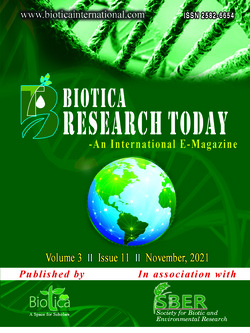
Pink Pigmented Facultative Methylotrophs (PPFMs): Bioinoculants for Sustainable Green Agriculture
Nysanth, N.S.*
Dept. of Agricultural Microbiology, University of Agricultural Sciences, GKVK, Bangalore, Karnataka (560 065), India
Sivapriya, S.L.
Dept. of Agricultural Microbiology, College of Agriculture, Vellayani, Thiruvananthapuram, Kerala Agricultural University, Kerala (695 522), India
Yashaswini, M.S.
Dept. of Agricultural Microbiology, University of Agricultural Sciences, GKVK, Bangalore, Karnataka (560 065), India
Anith, K.N.
Dept. of Agricultural Microbiology, College of Agriculture, Vellayani, Thiruvananthapuram, Kerala Agricultural University, Kerala (695 522), India
DOI: NIL
Keywords: Biocontrol, Methylobacterium, Methylotrophs, PPFMs
Abstract
Bacteria belonging to the genus Methylobacterium, known as pink pigmented facultative methylotrophs (PPFMs), are gaining remarkable attention as potential bio-inoculants in agriculture. They are aerobic, Gram-negative bacteria, characterized by the capability to grow on single carbon compounds such as formate, formaldehyde or methanol as the sole source of carbon and energy. PPFMs are found in a wide variety of habitats such as soil, dust, freshwater lake sediments, leaf surface and nodules with reported symbiotic association with more than a hundred plant species. These beneficial groups of bacteria enhance the growth and yield of host plants through multifaceted modes of action such as production of phytohormones, vitamin B12, siderophore, ACC deaminase, and nutrient acquisition. Moreover, they protect the plants by hindering infestation by various phytopathogens. Therefore, development of promising formulations of PPFMs with multiple beneficial traits could be an excellent alternative to agrochemicals in sustainable agriculture.
Downloads
not found
Reference
Green, P.N., 1992. The genus Methylobacterium. In: The prokaryotes, (Eds.) Balows, A., Truper, H.G., Dworkin, M., Harder, W. and Schleifer, K.H., Springer, Germany, pp. 2342-2349.
Laxmi, J., Palanichamy, V., Reddy, N., Rajsekaran, C., Kumari, N.V., Bhaskar, M., 2012. Standardization of cultivation parameters for the extraction of carotenoid from pink pigmented facultative methylotrophic (PPFM) bacteria. Asian J. Pharma. Clin. Res. 5, 187-192.
Madhaiyan, M., Poonguzhali, S., Senthilkumar, M., Seshadri, S., Chung, H., Yang, J., Sundaram, S., Sa, T., 2004. Growth promotion and induction of systemic resistance in rice cultivar Co-47 (Oryza sativa L.) by Methylobacterium spp. Bot. Bull. Acad. Sin. 45, 315-325.
Nysanth, N.S., Meenakumari, K.S., Syriac, E.K., Beena, R., 2019. Screening of pink pigmented facultative methylotrophs for growth enhancement in paddy. Biocatalysis Agric. Biotechnol. 18, 101055.
Trotsenko, Y.A., Ivanova, E.G., Doronina, N.V., 2001. Aerobic methylotrophic bacteria as phytosymbionts. Microbiol. 70, 623-632.
